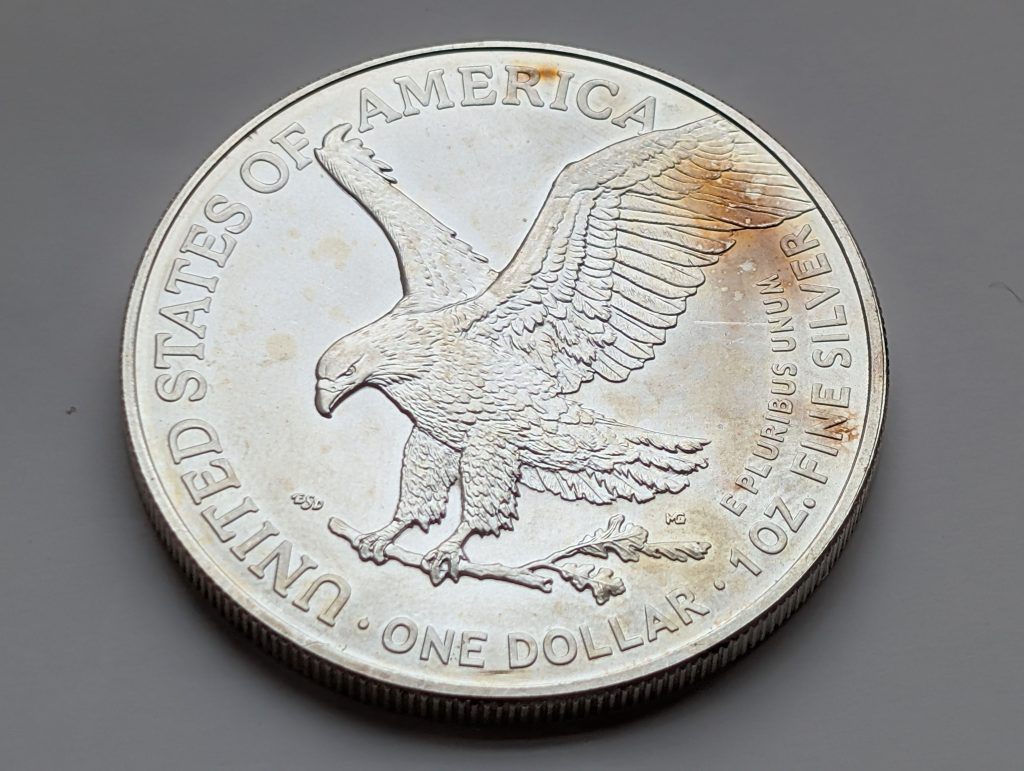Tarnish vs. Toning: What’s the Difference?
In the world of coin collecting, the line between “tarnish” and “toning” is surprisingly thin, and often debated. Both are surface changes caused by chemical reactions, usually with sulfur or oxygen, but one is often seen as damage while the other might add hundreds (or thousands) of dollars in value. So what’s the real difference? Is it scientific, aesthetic, or just marketing?
This post breaks it down so you can stop guessing and start making informed decisions about what’s on the surface of your coins, and what it means.
The Science Behind Tarnish and Toning

At a chemical level, tarnish and toning are extremely similar, they’re both caused by reactions between the metal in the coin and compounds in the surrounding environment, usually sulfur. What happens after that, though, depends on how much of the compound is present, how long the coin is exposed, and how the metal reacts.
- Tarnish typically shows up as a dull, blotchy, or streaky discoloration. It’s often the result of uneven exposure, higher humidity, or contaminated storage. Tarnish builds in layers and can trap moisture or contaminants beneath the surface, which is why it often leads to corrosion if left unchecked.
- Toning, by contrast, is usually more uniform and gradual. It forms thin layers of oxidation that can create colorful effects. blues, purples, ambers, especially on silver and copper coins. These layers still reduce the reflectivity of the metal but are often considered attractive and stable when they develop naturally and evenly.
The difference isn’t so much the chemistry as it is the appearance and context.
How Grading Companies Like PCGS Treat Tarnish vs. Toning
Grading services make a clear distinction between attractive toning and problematic tarnish, even though both are caused by similar surface reactions.
- Toning that develops naturally and adds visual appeal to the coin is not only acceptable but often celebrated. PCGS will straight grade toned coins as long as there’s no evidence of cleaning, corrosion, or artificial acceleration. In many cases, especially with rainbow-toned coins, the grade combined with the toning can dramatically increase the coin’s market value.
- Tarnish, on the other hand, is a red flag. When it’s splotchy, uneven, or obscures detail, PCGS is more likely to assign a Details grade with a qualifier like Environmental Damage. This is especially true if the tarnish has begun to etch into the metal or shows signs of underlying corrosion. Even when tarnish isn’t extreme, it can reduce a coin’s eye appeal and drop it into a lower grade bracket than an otherwise identical example.
Grading companies are in the business of balancing consistency with market standards, and in the market, eye appeal matters. So while the science behind toning and tarnish may be similar, the grading results are often worlds apart.
When Tarnish Turns to Trouble
Not all tarnish is benign. In fact, some cases can be the first step toward more destructive surface changes like corrosion. When tarnish thickens, darkens unevenly, or becomes sticky or powdery, it may indicate that chemical reactions are still active on the coin’s surface, especially if the coin has been stored in poor conditions.
Collectors should be wary of:
- Tarnish with texture — A gritty or crusty feel often points to corrosion beginning beneath the surface.
- Rapidly spreading dark spots — Especially near the rim, this could signal active oxidation, which may continue unless the coin is stabilized.
- Splotchy discoloration — Uneven patterns with dark centers and lighter halos may indicate a prior cleaning attempt, residue, or environmental damage.
It’s one thing for a coin to tone gracefully over decades in a paper envelope. It’s another for it to sit for five years in a damp garage. Knowing the difference helps you protect your collection and your wallet.
Wrapping Up: Toning or Tarnish?
Tarnish and toning share the same chemical roots, but they take different paths. Toning is what collectors hope for – balanced, attractive color from slow, natural exposure. Tarnish is what you get when conditions aren’t ideal, when the reaction oversteps and turns into dullness, darkness, or damage.
Learning to tell the difference takes time, but it’s worth the effort. Whether you’re pulling a coin from a childhood box or evaluating a high-grade Morgan dollar, understanding how surface changes form helps you become a sharper, more confident collector.
This is one of those foundational skills that pays dividends across your entire collection. Once you know what tarnish looks like, you’ll be better equipped to decide if it’s harmless, harmful, or downright beautiful.
